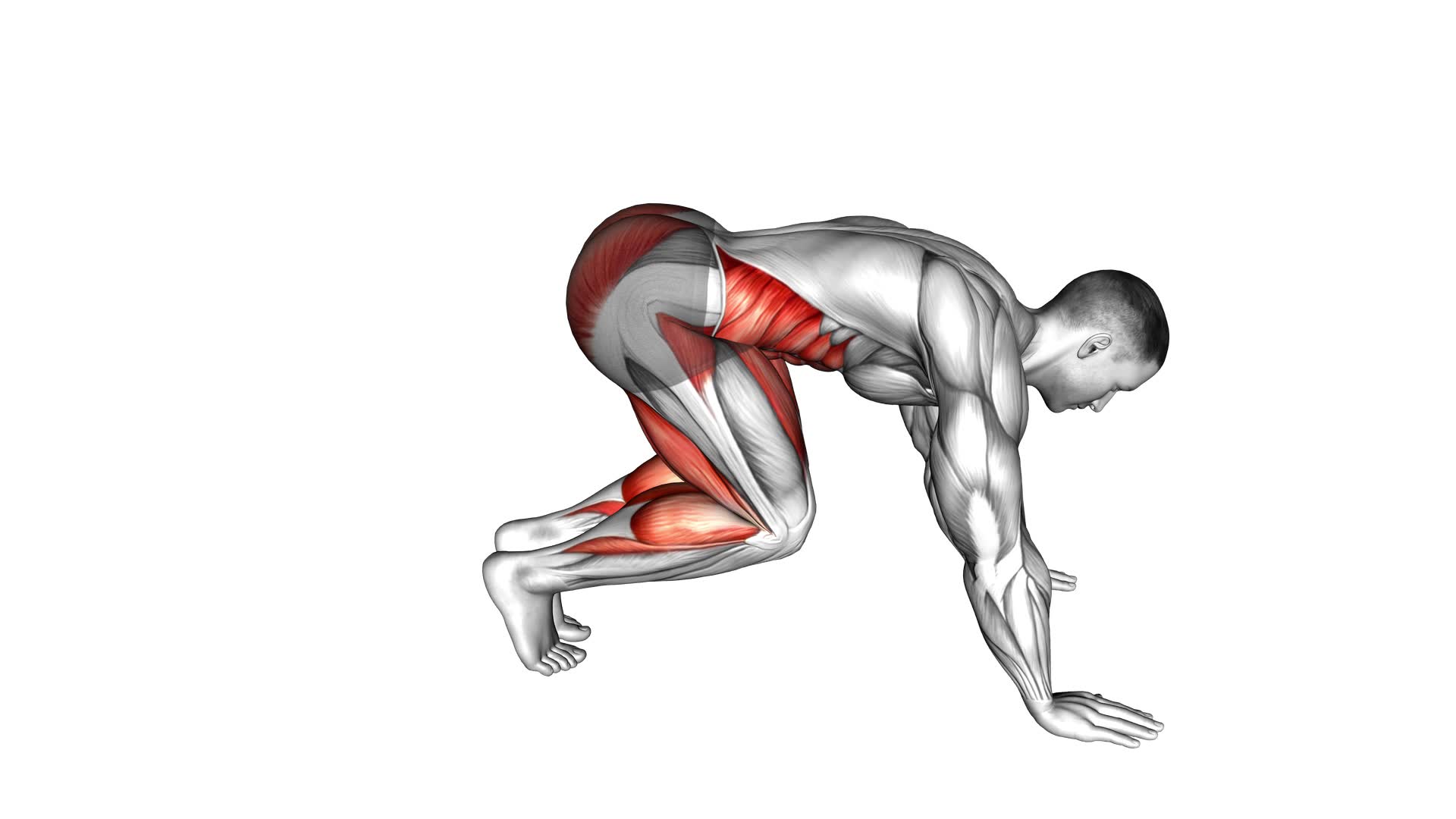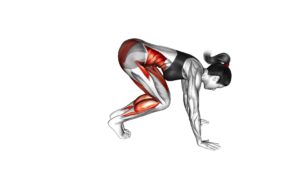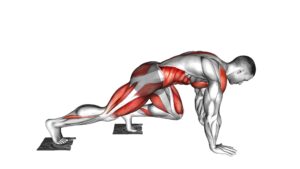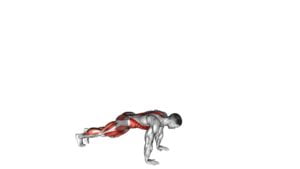Mountain Climber Walk – Video Exercise Guide & Tips

Are you looking to take your fitness routine to new heights? Get ready to conquer the mountain climber walk!
Watch This Exercise Video
This intense exercise targets multiple muscle groups while boosting your cardiovascular endurance.
In this video exercise guide, you'll learn proper form and technique, along with variations and modifications to suit your fitness level.
Maximize your results with these expert tips and get ready to climb towards your fitness goals!
Key Takeaways
- Mountain climber walks target multiple muscle groups, including abs, glutes, and shoulders.
- They improve cardiovascular endurance and engage core muscles for better stability and balance.
- Mountain climber walks can be modified and varied to add intensity and target specific muscle groups.
- Proper form is essential for maximizing results and preventing injury.
Benefits of Mountain Climber Walks
You will experience increased core strength and improved cardiovascular endurance with Mountain Climber Walks. This exercise targets multiple muscle groups, including your abs, glutes, and shoulders, making it an effective full-body workout.
One of the benefits of Mountain Climber Walks is their ability to engage your core muscles, helping to improve stability and balance. As you perform this exercise, you'll be working to maintain a plank position, which requires your core muscles to work harder to keep your body stable.
Additionally, the dynamic movements involved in Mountain Climber Walks can help to improve your cardiovascular endurance. By increasing the intensity and speed of your movements, you can elevate your heart rate and challenge your cardiovascular system.
Another advantage of Mountain Climber Walks is the ability to incorporate variations to suit your fitness level and goals. You can modify the exercise by adding resistance bands or performing it on an unstable surface to further challenge your muscles and increase the intensity.
Proper Form and Technique
To get the most out of your mountain climber walks, it's crucial to focus on proper form and technique. This ensures that you engage the correct muscles and minimize the risk of injury.
By maintaining a straight line from your head to your heels, avoiding common mistakes like rounding your back or sagging your hips, you can maximize the effectiveness of this exercise and achieve better results.
Incorporating a controlled and controlled movement is also important. This means avoiding rushing through the exercise and instead, focusing on maintaining a steady pace and rhythm.
Form Importance
Mastering proper form and technique is essential for maximizing the benefits of the Mountain Climber Walk exercise. When it comes to this exercise, form is of utmost importance. Here are five key reasons why technique matters:
- Prevents injury: By maintaining proper form, you reduce the risk of strains, sprains, and other injuries.
- Targets the right muscles: Correct technique ensures that you engage the intended muscles effectively, leading to better results.
- Improves balance and stability: Maintaining a stable and aligned position helps improve your balance and stability during the exercise.
- Enhances core strength: Proper form engages your core muscles, leading to improved core strength and stability.
- Increases intensity: By performing the exercise with proper form, you can increase the intensity and difficulty level, making it more challenging and effective.
Avoiding Common Mistakes
Continuing the discussion on proper form and technique, it's important to avoid common mistakes when performing the Mountain Climber Walk exercise.
By avoiding these mistakes, you can prevent injuries and optimize your workout.
One common mistake to avoid is allowing your hips to sag or rise too high, as this can put unnecessary strain on your lower back.
Another mistake is rushing through the exercise, sacrificing form for speed. Take your time and focus on maintaining proper alignment and engaging your core muscles.
Lastly, be mindful of your hand placement. Placing your hands too far forward or too close to your chest can cause wrist discomfort.
By avoiding these common mistakes, you can perform the Mountain Climber Walk exercise safely and effectively.
Now, let's move on to the next section and discuss technique for better results.
Technique for Better Results
To optimize your results and ensure proper form and technique, follow these guidelines for the Mountain Climber Walk exercise:
- Maintain a straight line from your head to your heels, engaging your core muscles throughout the exercise.
- Keep your hands directly under your shoulders and your wrists in line with your shoulders to avoid putting excessive strain on your joints.
- Alternate bringing your knees towards your chest, ensuring that each knee is brought as close to your chest as possible.
- Engage your glute muscles as you bring your knees forward, focusing on the contraction of the muscles.
- Breathe steadily throughout the exercise, inhaling as you bring your knee forward and exhaling as you extend your leg back.
Targeted Muscle Groups
To effectively target the muscle groups involved, perform the Mountain Climber Walk exercise with controlled movements and proper form. The mountain climber exercise primarily activates the muscles in your core, including the rectus abdominis, transverse abdominis, and obliques. These muscles help stabilize your torso and maintain proper alignment during the exercise. Additionally, the mountain climber walk engages the muscles in your upper body, including the deltoids, triceps, and chest muscles. These muscles work together to support your body weight and maintain balance as you perform the exercise.
Furthermore, the mountain climber walk also targets the muscles in your lower body, such as the quadriceps, hamstrings, and glutes. As you bring your knees towards your chest and alternate between legs, these muscles are activated to provide the necessary strength and stability. The continuous movement of the exercise also increases the cardiovascular demand, making it an effective exercise for improving cardiovascular fitness.
Cardiovascular Endurance Benefits
When you perform mountain climber walks, you aren't only working your muscles, but also reaping cardiovascular endurance benefits. This exercise gets your heart pumping, improving heart health and increasing stamina levels.
Heart Health Benefits
You can improve your heart health and cardiovascular endurance by incorporating the Mountain Climber Walk into your exercise routine. This exercise provides numerous heart health benefits and can help maximize your results.
Here are five reasons why the Mountain Climber Walk is great for your heart:
- Increases heart rate: The intense nature of this exercise raises your heart rate, providing a cardiovascular workout that strengthens your heart muscle.
- Improves circulation: The repetitive motion of the Mountain Climber Walk helps improve blood flow throughout your body, promoting better cardiovascular health.
- Boosts endurance: Regularly performing this exercise enhances your cardiovascular endurance, allowing you to engage in other physical activities for longer periods.
- Burns calories: The Mountain Climber Walk is a high-intensity exercise that helps burn calories, contributing to weight management and overall heart health.
- Reduces risk of heart disease: Engaging in exercises like the Mountain Climber Walk can lower your risk of developing heart disease by improving heart function and reducing cholesterol levels.
Incorporating the Mountain Climber Walk into your exercise routine can greatly benefit your heart health, helping you achieve optimal cardiovascular endurance.
Increased Stamina Levels
Boost your stamina levels and improve your cardiovascular endurance with the Mountain Climber Walk. This exercise is a great way to increase your endurance and build stamina. By incorporating this exercise into your routine, you can experience improved endurance and enhanced cardiovascular health.
The Mountain Climber Walk is a high-intensity exercise that targets multiple muscle groups while also challenging your cardiovascular system. It requires you to engage your core, arms, and legs, making it a full-body workout. As you perform this exercise, your heart rate increases, helping to improve your cardiovascular endurance.
To get the most out of the Mountain Climber Walk, focus on maintaining a steady pace and breathing deeply throughout the exercise. This will help to build your stamina and increase your overall endurance.
Incorporating this exercise into your routine, along with other stamina-building techniques, can help you achieve your fitness goals and improve your overall cardiovascular health.
Variations and Modifications
To modify the mountain climber walk, consider incorporating different variations for increased intensity and targeting specific muscle groups. Here are some mountain climber variations and modifications to help you spice up your workout routine:
- Elevated Mountain Climbers: Place your hands on an elevated surface, such as a bench or step, while performing the mountain climber exercise. This variation increases the range of motion and engages your core muscles even more.
- Cross-body Mountain Climbers: Instead of bringing your knees straight towards your chest, cross one knee towards the opposite elbow. This modification adds a rotational component, targeting your obliques and improving core stability.
- Spiderman Mountain Climbers: As you bring your knee towards your chest, extend your leg out to the side and try to touch your elbow with your knee. This variation increases the challenge on your hip flexors and inner thighs.
- Single-leg Mountain Climbers: Perform the mountain climber exercise with one leg at a time, keeping the other leg extended straight behind you. This modification enhances the workout for your glutes and hamstrings.
- Weighted Mountain Climbers: Add a weight, such as a dumbbell or a weighted vest, to increase the resistance and intensity of the exercise. This modification helps build strength and endurance in your upper body.
Incorporating these mountain climber variations and modifications into your workout routine can help you target different muscle groups and make your workouts more challenging and effective. Remember to always maintain proper form and listen to your body to prevent injuries.
Tips for Maximizing Results
For optimal results, incorporate these tips into your mountain climber walk routine.
- To maximize the intensity of your workout, focus on maintaining a fast pace throughout the exercise. This will keep your heart rate up and increase the calorie burn.
- You can also try incorporating intervals of high intensity, where you perform the mountain climber walk at a faster pace for a short period of time, followed by a recovery period at a slower pace. This technique, known as interval training, helps to increase cardiovascular endurance and burn more calories.
- Another tip for maximizing results is to gradually increase the difficulty of your mountain climber walk. This can be done through progressive overload, which involves adding resistance or increasing the duration or intensity of the exercise over time.
- For example, you can try wearing a weighted vest or ankle weights to add resistance to your mountain climber walk. Alternatively, you can increase the duration of the exercise by adding more sets or increasing the time spent performing the exercise.
Incorporating these tips into your mountain climber walk routine will help you maximize the intensity of your workouts and achieve better results over time. Remember to listen to your body and adjust the intensity and difficulty as needed to prevent injury and ensure continued progress.
Frequently Asked Questions
How Many Calories Can You Burn Doing Mountain Climber Walks?
When it comes to burning calories, mountain climber walks can be quite effective. The intensity level of this exercise can help you burn a significant amount of calories.
Without the context of the specific exercise, it's difficult to provide an exact number of calories burned. However, engaging in high-intensity activities like mountain climber walks is known to have a positive impact on calorie burning.
Remember to consult with a fitness professional for personalized guidance.
Can Mountain Climber Walks Help Improve Balance and Coordination?
Mountain climber walks are excellent balance and coordination exercises. They can greatly improve your overall stability and control. By engaging multiple muscle groups, these exercises challenge your body to maintain proper form and alignment. This helps to enhance your balance and coordination skills over time.
The benefits of mountain climber walks extend beyond just burning calories. Incorporating them into your fitness routine can help you develop a strong foundation and improve your overall physical performance.
Are Mountain Climber Walks Safe for Individuals With Knee or Back Issues?
Mountain climber walks can be a great exercise for improving balance and coordination. However, if you have knee or back issues, it's important to consider your safety.
Mountain climber walks put a lot of pressure on the knees and can strain the back. If you're experiencing knee or back pain, it's recommended to consult with a healthcare professional for proper knee pain management and to explore alternative exercises that are safer for individuals with back issues.
How Often Should Mountain Climber Walks Be Incorporated Into a Workout Routine?
Incorporating mountain climber walks into your workout routine can be beneficial for both your cardiovascular endurance and overall strength. The frequency of these exercises will depend on your fitness level and goals.
However, it's generally recommended to include them at least 2-3 times a week to see noticeable results. Mountain climber walks engage multiple muscle groups, including your core, arms, and legs, making them a great addition to any well-rounded workout routine.
Can Mountain Climber Walks Be Done on Different Surfaces, Such as Grass or Sand?
Mountain climber walks can be done on various surfaces, including grass or sand. Doing them on different surfaces adds variety to your workout routine and challenges your muscles in different ways.
When performed on grass, the uneven terrain can engage your core and stabilizer muscles more intensely.
On the other hand, doing mountain climber walks on sand can increase the resistance and provide a greater cardiovascular workout.
Conclusion
In conclusion, mountain climber walks are an effective exercise for improving cardiovascular endurance and targeting multiple muscle groups. By maintaining proper form and technique, you can maximize the benefits of this exercise.
Additionally, there are variations and modifications available to suit different fitness levels and goals. Incorporating mountain climber walks into your workout routine can help you achieve better overall fitness and enhance your physical performance.

Author
Years ago, the spark of my life’s passion ignited in my mind the moment I stepped into the local gym for the first time. The inaugural bead of perspiration, the initial endeavor, the very first surge of endorphins, and a sense of pride that washed over me post-workout marked the beginning of my deep-seated interest in strength sports, fitness, and sports nutrition. This very curiosity blossomed rapidly into a profound fascination, propelling me to earn a Master’s degree in Physical Education from the Academy of Physical Education in Krakow, followed by a Sports Manager diploma from the Jagiellonian University. My journey of growth led me to gain more specialized qualifications, such as being a certified personal trainer with a focus on sports dietetics, a lifeguard, and an instructor for wellness and corrective gymnastics. Theoretical knowledge paired seamlessly with practical experience, reinforcing my belief that the transformation of individuals under my guidance was also a reflection of my personal growth. This belief holds true even today. Each day, I strive to push the boundaries and explore new realms. These realms gently elevate me to greater heights. The unique combination of passion for my field and the continuous quest for growth fuels my drive to break new ground.



